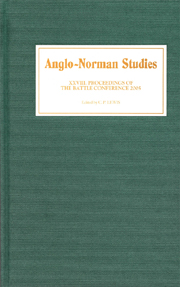Book contents
- Frontmatter
- Contents
- LIST OF ILLUSTRATIONS, MAPS, AND TABLES
- EDITOR'S PREFACE
- ABBREVIATIONS
- Inside the Anglo-Norman Family: Love, Marriage, and the Family (R. Allen Brown Memorial Lecture)
- Land Tenure and Royal Patronage in the Early English Kingdom: A Model and a Case Study
- The Homilies of a Pragmatic Archbishop's Handbook in Context: Cotton Tiberius A. iii
- Robert de Vaux and Roger de Stuteville, Sheriffs of Cumberland and Northumberland, 1170–1185
- The Common Steeple? Church, Liturgy, and Settlement in Early Medieval Lincolnshire
- The Question of Masculinity in William of Malmesbury's Presentation of Wulfstan of Worcester
- Share and Share Alike? Bishops and their Cathedral Chapters: The Domesday Evidence
- Dunstan and Monastic Reform: Tenth-Century Fact or Twelfth-Century Fiction?
- Domesday Now
Dunstan and Monastic Reform: Tenth-Century Fact or Twelfth-Century Fiction?
Published online by Cambridge University Press: 12 September 2012
- Frontmatter
- Contents
- LIST OF ILLUSTRATIONS, MAPS, AND TABLES
- EDITOR'S PREFACE
- ABBREVIATIONS
- Inside the Anglo-Norman Family: Love, Marriage, and the Family (R. Allen Brown Memorial Lecture)
- Land Tenure and Royal Patronage in the Early English Kingdom: A Model and a Case Study
- The Homilies of a Pragmatic Archbishop's Handbook in Context: Cotton Tiberius A. iii
- Robert de Vaux and Roger de Stuteville, Sheriffs of Cumberland and Northumberland, 1170–1185
- The Common Steeple? Church, Liturgy, and Settlement in Early Medieval Lincolnshire
- The Question of Masculinity in William of Malmesbury's Presentation of Wulfstan of Worcester
- Share and Share Alike? Bishops and their Cathedral Chapters: The Domesday Evidence
- Dunstan and Monastic Reform: Tenth-Century Fact or Twelfth-Century Fiction?
- Domesday Now
Summary
The traditional view of Dunstan's role in the English monastic revival of the tenth century, known as the Benedictine Reform, is as its instigator and leader. Dunstan has been seen as the pivotal force behind the vigorous promotion of ‘reformed’ Benedictine monasticism which revitalized the religious life in England during this time. As Knowles states
The beginning of the monastic revival in England, which set in being a life that was destined to endure till the Dissolution of the monasteries six hundred years later, may be dated from the year c. 940, when King Edmund, after his narrow escape from death on the cliffs of Cheddar, set Dunstan, still a young man, as ‘abbot’ in the church of Glastonbury.
This view of events holds that Dunstan's appointment to the abbacy of Glastonbury, at some point during the 940s, set in motion a series of events resulting in both the creation of new monastic institutions and the refoundation of existing houses, which were either derelict or inhabited by secular clerics, following the principles of the Rule of St Benedict. Responsibility for establishing the partnership between church and state in the promotion of Benedictine monasticism, epitomized by the relationship between King Edgar and Dunstan himself, has also traditionally been ascribed to Dunstan. The Benedictine Reform reached a climax with the council of Winchester, c. 975, from which emerged the great English customary, the Regularis Concordia, intended to standardize monastic observance throughout the entire kingdom.
- Type
- Chapter
- Information
- Anglo-Norman Studies 28Proceedings of the Battle Conference 2005, pp. 153 - 167Publisher: Boydell & BrewerPrint publication year: 2006



